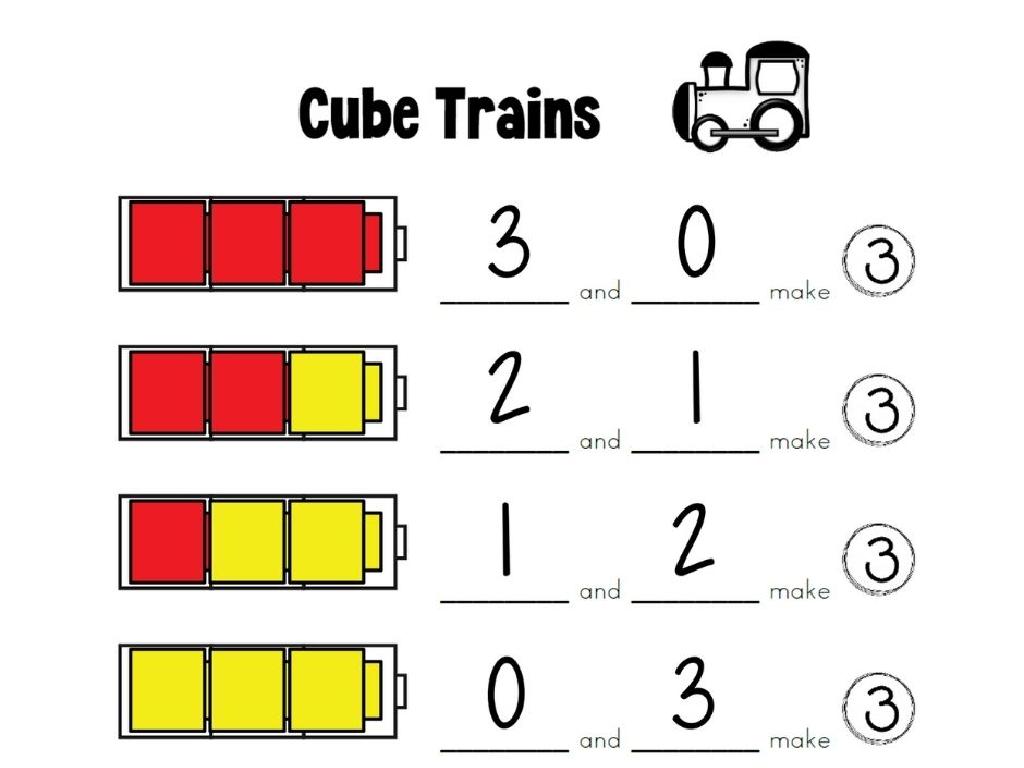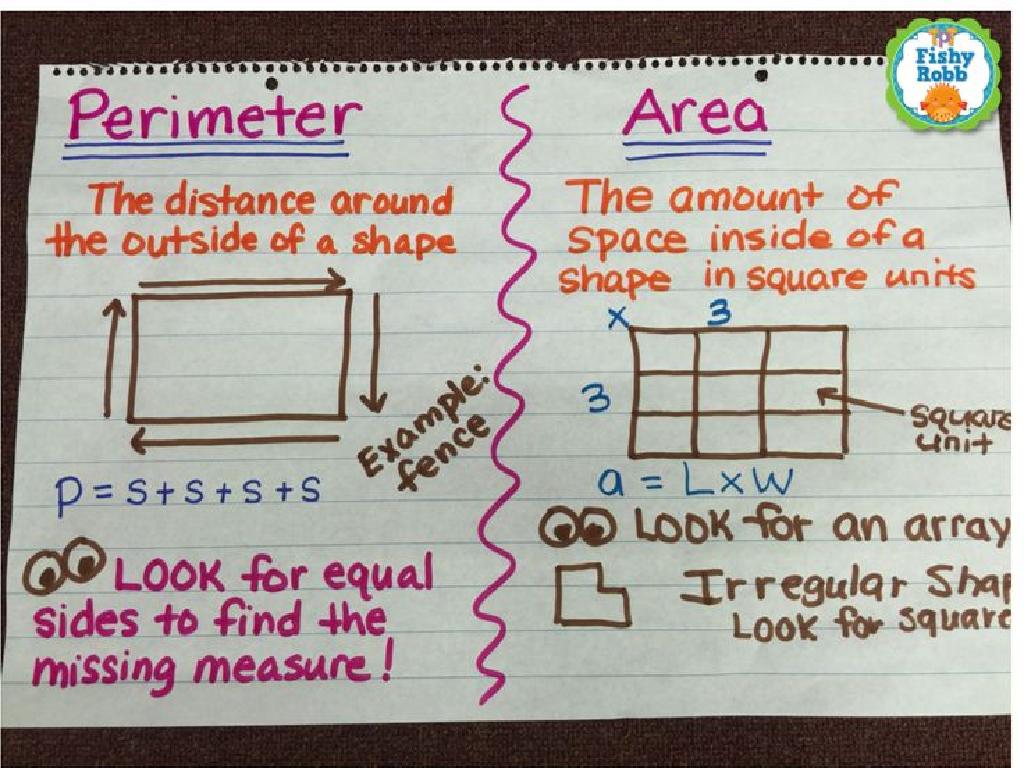Divide Powers: Variable Bases
Subject: Math
Grade: Eighth grade
Topic: Exponents
Please LOG IN to download the presentation. Access is available to registered users only.
View More Content
Introduction to Exponents
– Recap of exponent basics
– Exponents represent repeated multiplication
– Base and exponent explained
– Base is the number being multiplied; exponent shows how many times
– Examples of exponential expressions
– For instance, 3^2 means 3 multiplied by itself once (3*3)
– Significance of exponents in math
|
Begin the lesson by reviewing what exponents are, emphasizing their role as a shorthand for expressing repeated multiplication. Clarify the terms ‘base’ and ‘exponent’, ensuring students understand that the base is the number being multiplied, and the exponent denotes the number of times the base is used as a factor. Provide simple examples such as 2^3 or 5^2 to illustrate these concepts. Highlight the importance of exponents in various fields of mathematics, including algebra and scientific notation, to underscore their relevance and encourage students to appreciate the efficiency of using exponents in calculations.
Dividing Powers with the Same Base
– Rule for dividing powers
– When dividing like bases, subtract the exponents: x^m / x^n = x^(m-n)
– Example: x^m / x^n
– If x^5 / x^2, then x^(5-2) = x^3
– Subtracting exponents
– Subtracting exponents shows how many factors of the base remain
– Practical application
|
This slide introduces the concept of dividing powers with the same base, which is a fundamental rule in working with exponents. The rule states that when you divide powers with the same base, you subtract the exponents. For example, x^m / x^n becomes x^(m-n). This is because division is the inverse operation of multiplication, and subtracting the exponents effectively removes the number of times the base is multiplied by itself in the denominator from the numerator. It’s important for students to understand this concept as it simplifies expressions and is widely used in algebra. Provide additional examples and encourage students to practice with different bases and exponents to solidify their understanding.
Dividing Powers with Variable Bases
– Walk through example problems
– Let’s solve some problems as a class
– Apply the division rule for same bases
– When bases are same, subtract exponents: x^a / x^b = x^(a-b)
– Highlight common mistakes
– Don’t add exponents; remember to subtract them
– Practice problems together
– Work on practice problems to reinforce the rule
|
This slide is aimed at helping students understand the concept of dividing powers with variable bases. Start by solving example problems together to demonstrate the process. Emphasize the rule for dividing powers with the same base, which is to subtract the exponents. Point out common mistakes, such as adding exponents instead of subtracting, and provide tips to avoid them. Conclude with practice problems that students can work on, either individually or in groups, to solidify their understanding. Ensure that students are comfortable with the rule and can apply it to different problems before moving on.
Practice: Dividing Powers with Variable Bases
– Attempt practice problems individually
– Discuss methods with classmates
– Share strategies and compare answers
– Seek hints if you’re stuck
– Hints will help lead you to the solution
– Guidance will be provided
|
This slide is designed to engage students in active practice of dividing powers with variable bases. Students should work on problems independently to strengthen their understanding, then collaborate with peers to discuss different approaches to solving the problems. This peer interaction encourages learning from one another and can clarify misunderstandings. As the teacher, circulate the room to offer hints and guidance without giving away the answers. This will help students develop problem-solving skills and become more confident in their abilities. Possible activities could include solving problems on the board, group discussions, or peer teaching. Ensure that each student is participating and encourage them to ask questions.
Dividing Powers: Real-World Applications
– Understanding division of powers
– Radioactive decay calculations
– Calculate substance decay using exponents
– Relating to everyday experiences
– How division of powers is present in daily life
– Enhancing practical understanding
|
This slide aims to show students how the mathematical concept of dividing powers with variable bases is used in real-world scenarios, such as in the field of science with radioactive decay. Explain that the rate of decay can be expressed using exponents and division of powers helps in calculating how much substance remains after a certain period. Relate the concept to students’ everyday experiences by discussing how this type of math is used in various fields, from pharmacology to environmental science. Encourage students to think of other areas where they believe division of powers might be applicable. The goal is to make the abstract concept of exponents more tangible and to demonstrate the practical utility of what they learn in math class.
Class Activity: Dividing Powers with Variable Bases
– Form groups to create problems
– Develop division of powers problems
– Use different bases and exponents
– Exchange problems with another group
– Solve the received problems
– Show your solution steps clearly
|
This interactive group activity is designed to reinforce the concept of dividing powers with variable bases. Divide the class into small groups and instruct each group to create their own mathematical problems that involve dividing powers with different bases. Encourage creativity and ensure that the problems vary in difficulty. Once the problems are created, have the groups exchange their problems with another group for solving. This will not only engage students in problem creation but also in critical thinking as they solve their peers’ problems. As a teacher, circulate the room to provide guidance and ensure that each group understands the concept. After solving, facilitate a discussion where groups can explain their problem-solving strategies and the steps they took to reach the solution. This will help solidify their understanding of the rules of exponents when dividing powers with variable bases.
Review and Q&A: Dividing Powers with Variable Bases
– Summarize key lesson points
– When dividing powers with the same base, subtract exponents.
– Open floor for questions
– Feel free to ask about any part of today’s lesson.
– Emphasize practice importance
– Regular practice solidifies understanding.
– Clarify any confusion
– Let’s address any unclear concepts together.
|
This slide is meant to wrap up the lesson on dividing powers with variable bases. Start by summarizing the main points, such as the rule for subtracting exponents when dividing like bases. Encourage students to ask questions about any part of the lesson they found challenging. Remind them that mastering exponents requires practice, and offer additional problems for them to solve at home. Finally, use this time to clarify any misconceptions and ensure that all students are on the same page before moving on to the next topic. Provide examples if necessary to reinforce the concepts.
Homework: Practice Dividing Powers
– Solve assigned problems
– Attempt without using notes
– Use resources if needed
– Textbook, online videos, and study groups
– Review today’s lesson
– Reinforce the concept of dividing powers with variable bases
|
The homework for this lesson is designed to solidify the students’ understanding of dividing powers with variable bases. Assign a variety of problems that require students to apply the rules learned in class. Encourage them to try solving the problems independently before consulting their notes, fostering a deeper comprehension of the material. Remind them of the available resources they can turn to for assistance, such as their textbook, educational websites, online tutorial videos, and study groups. This will help them become more resourceful learners. Additionally, suggest that they review the day’s lesson to refresh their understanding of the concepts before starting the homework. Provide 4-5 different types of problems to cater to varying levels of difficulty and ensure a comprehensive practice session.





